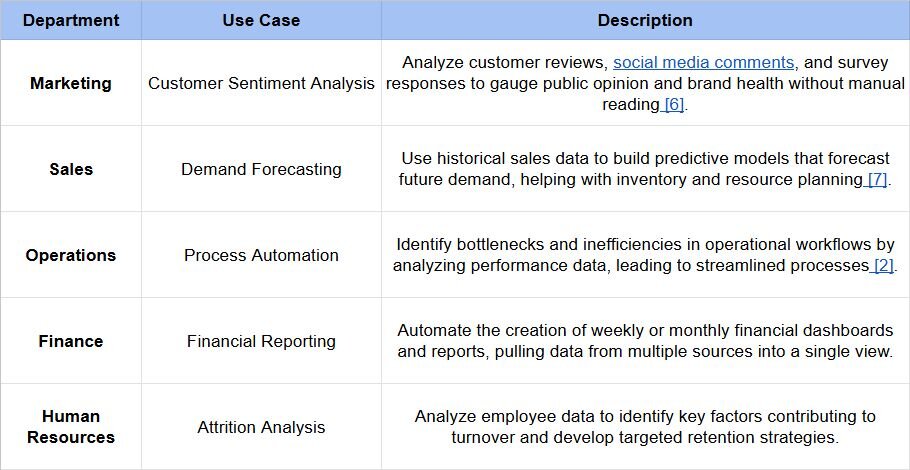August 7th, 2025
No-Code Analytics Platforms: Unlock Insights Without Programming
By Laura Clugston · 3 min read

The ability to extract meaningful insights from data is an important competitive advantage today.
Historically, this power was locked away, accessible only to those with specialized programming skills like Python, R, or SQL. This created a bottleneck, leaving business users, marketers, and decision-makers dependent on overstretched data teams. However, a new wave of technology is democratizing data analysis: the no-code analytics platform.
These platforms are data analysis solutions that empower anyone, regardless of their technical background, to explore data, create visualizations, and uncover actionable insights. By replacing complex code with intuitive visual interfaces and conversational language, they are transforming how organizations approach business intelligence.
What Are No-Code Analytics Platforms?
No-code analytics platforms are software tools designed to make data analysis accessible to non-technical users. They abstract away the complexity of programming by providing user-friendly features like drag-and-drop interfaces, pre-built templates, and visual query builders. The core mission of these platforms is to empower the people who know the business best (like the sales managers, marketing specialists, and operations leads) to answer their own questions using data.
Instead of writing lines of code to connect to a database, clean data, and generate a chart, a user can simply upload a file, connect to a data source, and start exploring. Platforms like Trevor.io, for example, empower users to build complex queries and dashboards through a no-code builder, effectively removing the engineering middleman for everyday reporting needs [1].
This shift allows organizations to foster a culture of data literacy and make faster, more informed decisions at every level [2].
The Rise of Natural Language in Data Analytics
A significant evolution within the no-code movement is the integration of Natural Language Processing (NLP). This branch of artificial intelligence enables computers to understand, interpret, and generate human language.
In analytics, this means users can "talk" to their data. Instead of navigating menus or building queries, you can ask a question in plain English, such as:
"What were our top-selling products in the Northeast region last quarter, and how does that compare to the same quarter last year?"
The platform's NLP engine, often powered by advanced transformer models, translates this request into a formal query, performs the analysis, and returns the answer as a chart, table, or written summary [3].
This conversational approach is the cornerstone of the new generation of natural language data analytics tools. Platforms like Julius AI exemplify this trend, providing an AI-powered conversational interface where analyzing data is as simple as having a conversation.
Users can upload a spreadsheet and ask the AI to identify trends, create visualizations, or even build predictive models, all without writing a single line of code. This makes sophisticated analysis, such as sentiment analysis from customer reviews or keyword extraction from reports, accessible to everyone [4].
Key Benefits of Adopting a No-Code Analytics Platform
Integrating a no-code analytics solution provides tangible benefits that extend beyond simple convenience.
• Democratization of Data: By removing technical barriers, these platforms empower employees across all departments to engage with data directly, breaking down information silos and fostering a more data-informed culture.
• Increased Speed and Agility: Business users can get answers in minutes, not days or weeks. This agility allows organizations to quickly respond to market changes, optimize campaigns on the fly, and seize opportunities faster than competitors [2].
• Reduced Costs: No-code platforms significantly lower the reliance on specialized data scientists and analysts for routine tasks. For small businesses and startups, this can reduce development and analysis costs, freeing up valuable technical resources to focus on more complex challenges [5].
• Improved Decision-Making: When domain experts can directly explore data, they can spot nuances and ask follow-up questions that a data analyst might miss. This leads to more relevant, context-aware insights and ultimately, better business outcomes.
Common Use Cases Across Industries
No-code analytics is not limited to a single function. Its applications span the entire organization.

Choosing the Right No-Code Analytics Platform
With a growing market, selecting the right tool requires careful consideration of your organization's specific needs. Here are the key factors to evaluate:
• Ease of Use: Is the interface truly intuitive for a non-technical user? A platform should guide the user through the analysis process, not present them with a new set of complex menus to learn.
• Data Source Integrations: Ensure the platform can easily connect to the data sources you rely on, whether they are simple CSV files, Google Sheets, cloud databases, or SaaS applications like Salesforce. Platforms like Looker Studio are known for their seamless integration with the Google ecosystem [8].
• Analytical Capabilities: Assess the depth of analysis offered. Does the tool excel at data visualization, or does it also support more advanced functions like predictive analytics, classification, and forecasting? [7].
• Scalability and Performance: The platform must be able to handle your data volumes as they grow. A solution that works well for a small startup should also be scalable enough to support an enterprise without a drop in performance [5].
• Collaboration and Sharing: How easy is it to share your findings? Look for features that allow you to export dashboards, generate shareable links, or embed analytics directly into other applications.
The Future is Conversational and Accessible
The movement toward no-code analytics is more than just a trend. It represents a fundamental shift in our relationship with data. By removing the barrier of code, these platforms are making data analysis a core competency for everyone, not just a select few.
The future of the no-code analytics platform is increasingly conversational. As AI and NLP technologies continue to advance, the experience of data analysis will become even more seamless. The ability to simply ask questions and receive instant, accurate insights, as pioneered by tools like Julius, is becoming more common.
This evolution is delivering on the promise of data-driven decision-making for all, unlocking a new level of collective intelligence within organizations.
Meta Description
Discover no-code analytics platforms that empower anyone to unlock data insights without programming, using intuitive interfaces and natural language queries for faster decisions.
